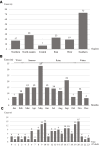Malayan Pit Viper Envenomation and Treatment in Thailand
- PMID: 34876815
- PMCID: PMC8643212
- DOI: 10.2147/TCRM.S337199
Malayan Pit Viper Envenomation and Treatment in Thailand
Abstract
Introduction: The Malayan pit viper (MPV; Calloselasma rhodostoma) is a hematotoxic snake found in all regions of Thailand and many countries in Southeast Asia. Treatment of MPV envenomation varies among facilities due to their capabilities.
Materials and methods: This study was a retrospective review of patients with MPV envenomation who were reported to the Ramathibodi Poison Center from 1 July 2016 to 30 June 2018.
Results: Of the 167 patients (median age, 40.5 years; range, 1.3-87.0 years) bitten by an MPV, the most common bite site was the foot (29.3%). Most patients reached the hospital within 1 hour of being bitten. One-hundred fifty-six patients (93.4%) had local effects from envenomation; 17 patients (10.2%) had severe local complications including necrotizing fasciitis (3.0%) and compartment syndrome (7.2%). Systemic effects such as hemorrhage and abnormal hemostasis occurred in 147 patients (88.0%). Additional effects included abnormal venous clotting time in 123 patients (73.7%), unclotted 20-minute whole blood clotting time in 57 patients (34.1%), low platelet counts (<50,000/µL) in 29 patients (17.4%), prolonged international normalized ratio (>1.2) in 51 patients (30.5%), and systemic bleeding in 14 patients (8.4%). The median onset of bleeding disorder was 6 hours. Monitoring for 24, 48, and 49 hours after bite enabled detection of systemic effects in 94.2%, 99.3%, and 100.0%, respectively. Three hundred fifteen courses of antivenin were administered to 144 patients (86.2%). All the patients who received antivenin recovered from bleeding disorder. Only 7.0% of antivenin doses were administered without Thai Red Cross indications. Allergic reactions from antivenin occurred in 34.7% of the 144 patients. One hundred thirty patients (77.8%) received antibiotics, and 32 patients (19.2%) required surgical management, including debridement and fasciotomy.
Conclusion: MPV envenomation results in local and systemic effects. Most systemic effects were abnormal clotting test results. Most patients reported onset of bleeding disorder within 48 hours.
Keywords: Malayan pit viper; antivenin; hematotoxin; onset of abnormality; snake venom.
© 2021 Tangtrongchitr et al.
Conflict of interest statement
The authors report no conflicts of interest.
Figures



Similar articles
-
Sensitivity and specificity of 20-minute whole blood clotting test, prothrombin time, activated partial thromboplastin time tests in diagnosis of defibrination following Malayan pit viper envenoming.Toxicon. 2020 Oct 15;185:188-192. doi: 10.1016/j.toxicon.2020.07.020. Epub 2020 Jul 24. Toxicon. 2020. PMID: 32712023
-
Clinical Laboratory Investigations and Antivenom Administration after Malayan Pit Viper (Calloselasma rhodostoma) Envenoming: A Retrospective Study from Southernmost Thailand.Am J Trop Med Hyg. 2024 Jan 30;110(3):609-617. doi: 10.4269/ajtmh.23-0657. Print 2024 Mar 6. Am J Trop Med Hyg. 2024. PMID: 38295421 Free PMC article.
-
Hematotoxic Manifestations and Management of Green Pit Viper Bites in Thailand.Ther Clin Risk Manag. 2020 Jul 30;16:695-704. doi: 10.2147/TCRM.S261303. eCollection 2020. Ther Clin Risk Manag. 2020. PMID: 32801726 Free PMC article.
-
Snake bite: pit vipers.Clin Tech Small Anim Pract. 2006 Nov;21(4):174-82. doi: 10.1053/j.ctsap.2006.10.008. Clin Tech Small Anim Pract. 2006. PMID: 17265901 Review.
-
Overview and controversies in the medical management of pit viper envenomation in the dog.J Vet Emerg Crit Care (San Antonio). 2011 Oct;21(5):461-70. doi: 10.1111/j.1476-4431.2011.00677.x. J Vet Emerg Crit Care (San Antonio). 2011. PMID: 22316194 Review.
Cited by
-
Early Adverse Reactions to Snake Antivenom: Poison Center Data Analysis.Toxins (Basel). 2022 Oct 9;14(10):694. doi: 10.3390/toxins14100694. Toxins (Basel). 2022. PMID: 36287963 Free PMC article.
-
Clinical Profile and Pharmacological Management of Snakebites in Community Care Units: A Retrospective Study Using Two Military Hospital Databases in South Thailand.Trop Med Infect Dis. 2023 Jun 29;8(7):346. doi: 10.3390/tropicalmed8070346. Trop Med Infect Dis. 2023. PMID: 37505642 Free PMC article.
-
A Retrospective Cohort Study of Cobra Envenomation: Clinical Characteristics, Treatments, and Outcomes.Toxins (Basel). 2023 Jul 20;15(7):468. doi: 10.3390/toxins15070468. Toxins (Basel). 2023. PMID: 37505737 Free PMC article.
-
Venom-gland transcriptomics of the Malayan pit viper (Calloselasma rhodostoma) for identification, classification, and characterization of venom proteins.Heliyon. 2023 Apr 19;9(5):e15476. doi: 10.1016/j.heliyon.2023.e15476. eCollection 2023 May. Heliyon. 2023. PMID: 37153433 Free PMC article.
-
Histopathological Changes in the Liver, Heart and Kidneys Following Malayan Pit Viper (Calloselasma rhodostoma) Envenoming and the Neutralising Effects of Hemato Polyvalent Snake Antivenom.Toxins (Basel). 2022 Aug 30;14(9):601. doi: 10.3390/toxins14090601. Toxins (Basel). 2022. PMID: 36136539 Free PMC article.
References
-
- Vongphoumy I, Chanthilat P, Vilayvong P, et al. Prospective, consecutive case series of 158 snakebite patients treated at Savannakhet provincial hospital, Lao People’s Democratic Republic with high incidence of anaphylactic shock to horse derived F(ab’)2 antivenom. Toxicon. 2016;117:13–21. doi:10.1016/j.toxicon.2016.03.011 - DOI - PubMed
LinkOut - more resources
Full Text Sources

